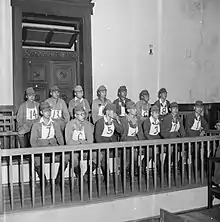Kalagon massacre
On 7 July 1945, the Kalagon massacre was committed against inhabitants of Kalagon, Burma (present-day Myanmar), by members of the 3rd Battalion, 215th Regiment and the OC Moulmein Kempeitai of the Imperial Japanese Army. These units had been ordered by Major General Seiei Yamamoto, chief of staff of the 33rd Army, to sweep the area for guerrillas reportedly teamed with British paratroops.
| Kalagon massacre | |
|---|---|
| Part of the Burma Campaign of World War II | |
 Japanese prisoners in the dock during the first war crimes trial to be held in Rangoon, Burma. These men were charged with the murder of 637 civilians in the village of Kalagon (1946). | |
| Location | Kalagon, Burma |
| Coordinates | 16°32′57″N 97°43′46″E |
| Date | 7 July 1945 |
| Target | Villagers |
Attack type | Massacre, war rape, torture |
| Deaths | 600–1,000 |
| Perpetrators | Imperial Japanese Army
|
| Motive | Punishment for aiding British commandos |
The Japanese occupied the village and rounded up all the inhabitants, some to the local mosque and others to different buildings, for questioning. Women and children were raped and beaten. After it was confirmed that they had aided British commandos, Major Ichikawa Seigi ordered the entire village to be massacred. The inhabitants were taken in groups of four to ten people to nearby wells, blindfolded, and bayoneted, and their bodies were dumped in the wells. The village was then burned to the ground. An estimated 600 to 1,000 villagers died in the massacre.[1]
The Japanese kidnapped 10 female survivors who agreed to act as "spies", albeit it is believed that they were instead used as comfort women. Two of them escaped, but the others disappeared.[1][2]
Prosecutions
Because the Japanese had conducted the massacre rather hastily, multiple villagers survived the massacre. The survivors became witnesses in war crimes proceedings against some of the participants in the massacre.[1]
In 1946, a British military court tried Seigi and 13 other soldiers for participating in the massacre. Each of them were tried on two counts:
- Participating in the massacre of the villagers
- Participating in the beating, torture, wounding, and other maltreatment of the villagers
Seigi also faced a third charge for kidnapping the women. Ten of them were found guilty. Seven of them were found guilty on both counts, and three others were only found guilty on the second count. Seigi was found guilty on all counts.[2]
Seigi and three officers who supervised the massacre were sentenced to death. The court said Seigi would be hanged, while the other three men would be shot by firing squads.[2] As for the other three soldiers deemed complicit in the massacre, the court found that they had not directly participated in the massacre. Instead, they had acted as accessories, As such, each of them were given 10-year sentences.[2]
Individual defendants and sentences
| Name | Charges | Sentence | Count 1 | Count 2 |
|---|---|---|---|---|
| *Major Ichikawa Seigi | Ordered massacre | Death by hanging | Guilty | Guilty |
| Captain Sakamaki Saburo | Provided transportation to accomplices and witnessed interrogations | 10 years imprisonment | Guilty | Guilty |
| Captain Okubo Yozo | Relayed the orders to carry out the massacre | 10 years imprisonment | Guilty | Guilty |
| Captain Yanagisawa Izumu | Supervised the massacre | Death by firing squad | Guilty | Guilty |
| Captain Midorikawa Hisashi | Supervised the massacre | Death by firing squad | Guilty | Guilty |
| Second Lieutenant Usui Kiyohiro | Accused of raping a woman | Acquitted | Not guilty | Not guilty |
| Lieutenant Tajima Ichiro | Supervised the massacre | Death by firing squad | Guilty | Guilty |
| Lieutenant Takei Shozo | Stood guard outside of the village as the massacre happened | 10 years imprisonment | Guilty | Guilty |
| Captain Higashi Noburo | Accused of instructing his subordinates to use force during interrogations | Acquitted | Not guilty | Not guilty |
| Warrant Officer Fujiwara Ryozo | Abusing villagers during interrogations | 5 years imprisonment | Not guilty | Guilty |
| Sergeant Major Kobayashi Akira | Abusing villagers during interrogations | 5 years imprisonment | Not guilty | Guilty |
| Sergeant Nagata Teshiyuki | Not involved | Acquitted | Not guilty | Not guilty |
| Sergeant Nomoto Kinni | Abusing villagers during interrogations | 7 years imprisonment | Not guilty | Guilty |
| Corporal Morimoto Seiichi | Served as a cook for the military police | Acquitted | Not guilty | Not guilty |
| *Seigi also faced a third charge for kidnapping the women | ||||
Each of the sentences were confirmed upon review. Seigi and his three condemned codefendants were executed on 15 July 1946, using the methods prescribed by the court.[2] The others were sent to the local jail in Rangoon to serve out their sentences. In mid-1951, those still in prison were transferred to Sugamo Prison in Japan to serve out the rest of their time.[3]
General Heitarō Kimura, one of the defendants at the International Military Tribunal for the Far East, was charged multiple counts, including his failure to prevent atrocities, including the Kalagon massacre. He was sentenced to death and executed in 1948.
See also
References
Citations
- Lingen, Kerstin von (2016-11-04). War Crimes Trials in the Wake of Decolonization and Cold War in Asia, 1945-1956: Justice in Time of Turmoil. Springer. ISBN 978-3-319-42987-8.
- "Kalagon Trial". legal-tools.org.
- Cribb, Robert (2016). "The Burma Trials of Japanese War Criminals, 1946-1947". War Crimes Trials in the Wake of Decolonization and Cold War in Asia, 1945-1956: Justice in Time of Turmoil (World Histories of Crime, Culture and Violence): 117–142.